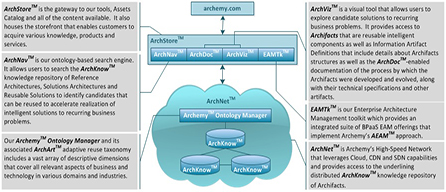Methodology
ArchDev™ and its Architecture Evolution Life Cycle (AELC™) complement and address Agile/DevOps inefficiencies in the area of architecture management.
ArchDev™
Archemy's ArchDev™ proprietary methodology integrates several aspects:
Ensures maximum exploitation of Adaptive Reuse of the Archifacts in the Archemy™ Assets Catalog to accelerate implementations and minimize costs and risks, which helps customers avoid "reinventing the wheel".
Creates documentation by-products consistent with Archemy's Ontology and Taxonomy, which ensures a continued ability to compare the business solutions and related architectures that Archemy™ implements for its customers with the evolving landscape of business problems, tools and software products and services.
Ensures best-of-breed architectures that can be monetized by being resold through the Archemy™ Assets Catalog.
AELC™
ArchDev's Architecture Evolution Lifecycle (AELC™) methodology provides the following stages:
Inception:
Evaluates candidate intelligent solutions and related architectures via Archemy's tool-enabled selection and customization of reusable assets that apply to business problems, and/or creation of new best-of-breed intelligent solutions and related architectures when required.
Elaboration:
Implementation:
Deployment:
Ontology and Taxonomy
Archemy's Ontology and Taxonomy is an Enterprise Architecture-focused tacit/explicit knowledge classification scheme that can be expanded without limit and which can accommodate dimensions that are completely orthogonal to one-another. This enables searches by users of completely different perspectives to produce valid results for each. By adding or deleting search dimensions, it is often possible to identify non-obvious solutions of interest that might never have been found using traditional means because they were tied to a domain not the searcher’s own.
ArchART™
ArchARTtrade; is Archemy's reference taxonomy that describes technical solutions.
Accelerators
EAMTk™ The Enterprise Architecture Management Toolkit is a Cloud-based integrated suite of BPaaS Agile EAM offerings that leverage centralized EA metamodel information and assets for use with other Archemy™ tools. EAMTk&trade implements the AEAM™ approach, which is based on the ArchDev™ methodology.
ArchNet™ is Archemy's High-Speed Network (leverages Cloud, CDN, and SDN capabilities) on which all of the Archemy™ tools and repositories are hosted.
ArchKnow™ is Archemy's Enterprise Meta-Components' Repository for Reusable Intelligent Archifacts, which contains the Archemy™ Assets Catalog and related tacit and explicit knowledge, the Ontology and Taxonomy and supporting knowledge for all implementations of myArchemy™ Assets Catalogs.
ArchNav™ is Archemy's Ontology-driven search engine that provides users with an entry point to the Archemy™ Assets Catalog.
ArchDoc™ is Archemy's Solution Development Life Cycle Documentation Tool, which is capable of capturing and presenting material created in a variety of content tools.
ArchViz™ is Archemy's Visual Solution Exploration Tool.
ArchStore™ is Archemy's web-enabled Meta-Components' e-store, operated by MetaComp, Inc. via metacomp.com, through which customers can purchase or subscribe to Archemy™ on-the-shelf products or services.
myArchemy™ is Archemy's partner-specific online repository and store.
ArchCell™ is Archemy's ArchCellerator™ semi-automated BPaaS Innovation Management Platform.
ArchiFacts
The Archemy™ Assets Catalog stores reusable best practice intelligent business solutions and related components as well as all the artifacts that were created during their development.
KADs and IADs
The two types of items contained in the Archemy™ Assets Catalog are as follows:
- Knowledge Artifact Definitions (KADs), which are intelligent components, or ArchiFacts, that can be adapted and reused to accelerate and reduce the risks associated with implementing software solutions. These components contain the answers to business questions and issues (a.k.a., the problem that a solution is intended to address, along with factors that influenced the design that was implemented ) that motivates their placement as business solutions in the catalog.
- Information Artifact Definitions (IADs), which are textual, tabular or graphical documents that corresponds to the artifacts that were implemented as individual KADs were developed. Information contained in the IADs can contribute to the ability to evaluate the appropriateness of a solution. Graphs of the end-to-end paths that were followed to develop individual KADs are also captured as IADs so that the timing and context of the creation of other artifacts can be memorized in the catalog.
The Archemy™ Assets Catalog contains both types of items for each solution or component and for simplicity, Archemy™ refer to the reusable intelligent solutions or components as KADs.
KAD Classification
Every KAD in the Catalog is classified according to the Archemy™ Ontology and Taxonomy. The Ontology and Taxonomy is multidimensional, with each dimension being orthogonal to all of the others. This means that any KAD may be characterized by any or all of the dimensions embodied in the Ontology and Taxonomy. Furthermore, ArchNav™, the search tool used to filter KADs from the Catalog, is designed so that it can automatically accommodate any new dimensions that may be added to the Ontology and Taxonomy at any time and users may narrow or widen a search by increasing or decreasing the number of dimensions employed.
The dimensions address a number of characteristics of both problems and solutions, including:
business forces, which are factors that influence the solutions' characteristics, such as regulatory requirements or time sensitivity, and
It is important to note that the Ontology and Taxonomy represent both problems and solutions. This means that users can focus a search on a problem domain or a solution type or both. Thus, ArchNav™ provides the opportunity to find solutions that may have been created for a different domain than that of the user in search of a solution but which are appropriate and applicable to the problem this particular user is trying to solve.
Searching for ArchiFacts
Licensed users may access ArchNav™ via the Explore Assets Catalog and search the Catalog for solutions of interest. Search parameters may be saved so that users can rerun a search that returns solutions or KADs that may be relevant to them.
